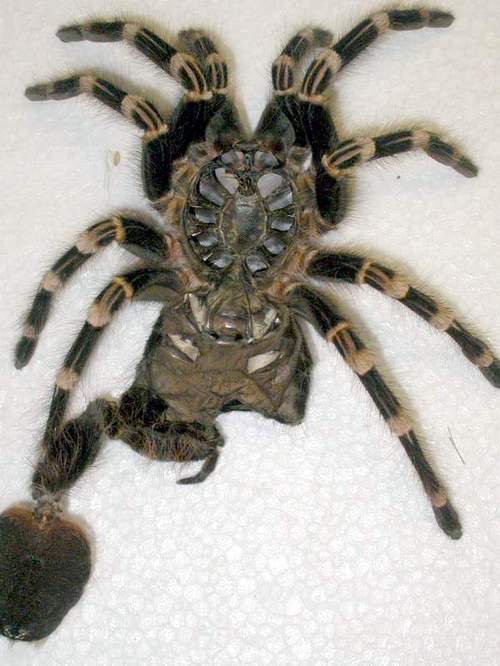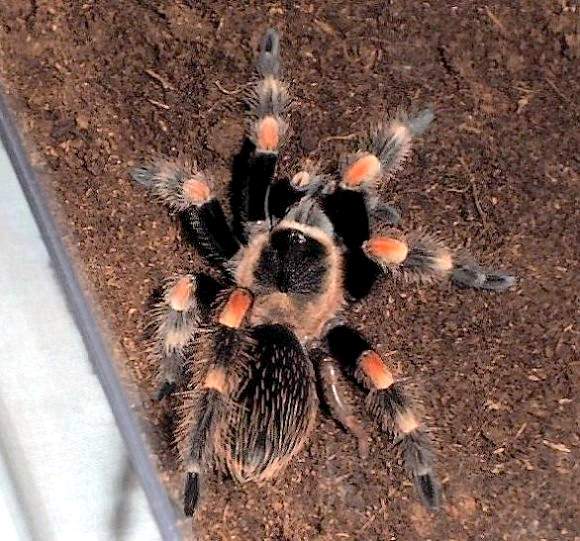Molting process.
| Stages of molting |
Process of molting |
| Regeneration |
The only defect of exoskeleton of spiders – that it can not sprawl or otherwise to increase in size, providing constant growing of its owner. Evolutionally this there was solved by way of its change on new exoskeleton, of lager size, which forms under old else before its change.
Scientifically this process divides on 4 stage, which have no clear delimitation comparatively each other, – proecdysis, ecdysis and postecdysis, as well as, so-called, intermolting stage. Completely whole this round-robin process beside adult spiders occupies about year, most of which they inhere in intermolting stage, and in definable time a combination of hormones causes activation of new cycle.
Approach of moltings is possible to define as follows: bald area on abdomen begins to get dark inside, since old exoskeleton transparents and through it is seen arising of a new, hairs of which has dark coloration (at this time a spider already, as a rule, ceases to eat). Usually this occurs aproximately at two weeks before molting begins.
Approximately in this time between new and old exoskeleton stands out exuvial liquid, softenning the under-stratum of old exoskeleton – endocuticle. This process calls apolysis.
At the end of proecdysis stage tarantula is turned over on back and molts in such position. Many spiders particularly which are right before catching from nature makes special globous web for molting. Sometimes molting of tarantulas occurs in vertical position (the reason of such difference is unknown).
During molting an old exoskeleton is weakenned on sides and in centre, diverged, and tarantula comes out of it in new exoskeleton. This process can last from twenty minutes to several hours, particularly long-lasting beside very large specimens. On completion of molting a spider leaving out of old exoskeleton certain time inheres in former position.
New exoskeleton has pleats, which is straightening (at the expense of pressures of hemolymph) and forming its chitinum and sclerotinum solidifying. In this time a tarantula does not eat and absolutely helpless: can not protect itself, quickly move. Any disturbing of tarantula during this time is restricted!
 Remained after molting old exoskeleton calls exuvium and can tell a lot about internal anatomy of tarantula, as well as allows to determine its sex. The periods of time, going between moltings (instar), different on length and depends on tarantula age, environment conditions (temperature and humidity) as well as conditions of feeding and also this period extends as far as tarantula grows.
Remained after molting old exoskeleton calls exuvium and can tell a lot about internal anatomy of tarantula, as well as allows to determine its sex. The periods of time, going between moltings (instar), different on length and depends on tarantula age, environment conditions (temperature and humidity) as well as conditions of feeding and also this period extends as far as tarantula grows.
Newborn spiderlings molts usually aproximately once in a month (sometimes more often – in dependencies from temperature-hunidity mode of keeping and feeding), beside adults – once in three year (females of last ages).
Because of spiders are creatures which metabolism stright depends on external environment conditions it is allows to artificially adjust intensity of growing and maturation of tarantula in captivty: under high temperature and plentiful of food it will grow on order quicker, than in conditions of irregular feeding and lowered temperature.
Hereunder, appears a possibility to delay to several months if required, for instance, coming of the sexual maturation of male.

Here is possible to mention of the remarkable ability of tarantulas to regenerate their lost limbs including pedipalps, chelicerae and spinnerets. Spiders, which on one or another reason lost their leg (as a result of traumas, hold ups of predator, breaches of molting etc.), with each molting increase them, and, as a rule, on passing 2 molts the damaged leg is completely regenerated.
The same has been found in the case of lost chelicerae (single or both) with the exception that this part of the spider has usually been regenerated within one following 1 molt (possibly due to a importance of chelicerae in specimen).
On the contarary, the lost spinnerets last over 2-3 molts to regenerate.
So, if You've found Your tarantula without legs, pedipalps or chelicerae do not panic - if the spider in good condition the losted appendage will soon regenerate.
Beside young spiders this occurs, as a rule, in all cases, so also beside females since they grow during whole its lifes but male being lost his leg in one of the last ages, can already not to have time to to regenerate losted limb, since its growing is limited by last (ultimate) molt.